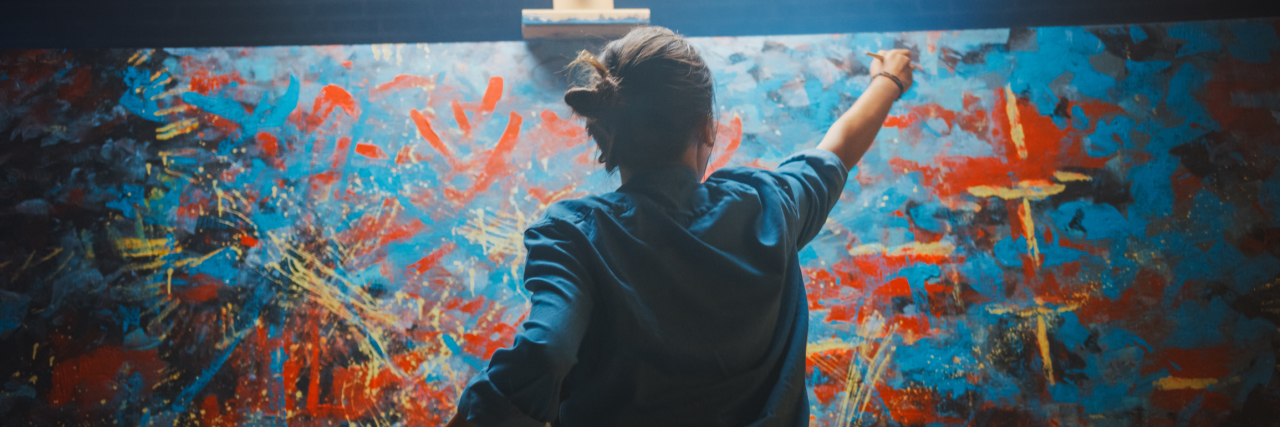Art therapy is a creative approach to improving one’s life. This can be done in many ways, such as drawing, coloring, painting, sculpting and many more art forms. These activities can help self-esteem and awareness, as well as helping the person create a better physical, emotional and mental state. Art therapy can be beneficial to those who do not feel they can verbalize how they are feeling and instead can use different mediums to express feelings and emotions.
I asked started asking people what type of therapy they had thought of using or had used (if any). The most frequent answer was cognitive behavioral therapy (CBT) which is commonly used to treat anxiety and depression and is provided free by the National Health Service (NHS). I was curious only one or two people mentioned art therapy.
CBT creates a mind-body connection in the patient, that has seen to be grounding as well as healing. Grounding is a technique sometimes taught in CBT to patients with anxiety. You can ground yourself in different ways. A common way is using all your senses — things you can see, touch, smell, hear and feel. While creating art, we will subconsciously do all of these things. You will see the art you are creating, smell the medium, hear the sounds of motion and feel the art being created by your touch.
In art therapy, the client has all the control. This can be beneficial when someone has had all control taken away from them in their trauma. This allows the client to feel powerful and more expressive, being comfortable in the unknown. Art therapy allows space for joy and connection to the inner child. When children are growing up in a toxic or unsafe environment, sometimes it cannot feel safe to play when your instinct is set to survival mode. Art therapy allows that playfulness to emerge and offers a structure with flexibility.
Art therapy can be seen in different lights. Without a therapist, people can still experience the therapeutic values that come with being creative. Within the comfort of your own home, you can draw, make clay sculptures or collages using the elements to express yourself. However, working with a licensed art therapist will be at a greater advantage to the individuals as the activities can be personalized to the person’s needs. Art therapy can sometimes be administrated in a group setting which can help build connections with other people while being creative. This may be as beneficial as the creating of the art, as having healthy connections can be beneficial for fighting depression.
While seeing an art therapist may seem like an easy option compared to talking therapy, it can be difficult exposing yourself in the setting and potentially equally as painful revisiting traumatic memories.
Studies show there is a release of dopamine when being creative; when we do something pleasurable, the chemical is released and essentially makes us feel happier. This can have a positive effect when dealing with anxiety or depression and is a boost to self-esteem. A chain event occurs where the patient comes to understand themself on a deeper level, and consequently, communication becomes easier and emotion roadblocks are tackled.
We look at artists like Tracey Emin, for example, and her installation entitled “My Bed,” which is made up of a mattress, linen, pillows and a range of objects such as razors, newspapers, empty alcohol bottles and cigarette ends. It has been described as emotion in its rawest form. Following a breakup, Emin took to her bed, and once she finally found the strength to get up, she considered the mess around her and thought of it as a work of art. The outcome of her distress is aired for the world to see and creates an atmosphere in which her emotions become an art form.
I don’t know about you, but when I have previously been in similar states, I have never considered it to be art. Maybe it’s time I started looking at my trauma as an art form, helping me to heal, rather than hurt further looking at the mess that surrounds me. Emin’s work revolves around traumas, her weaknesses, fears and obsessions. She is the perfect example of using art as a form of self-expression.
Louise Bourgeois is best known for her large-scale sculptures. The depth of her childhood traumas affected her later in life and shaped the way she worked. Over her career, her works changed, and she developed as a person. Originally, her work focused on painting and printmaking; however, as time went on, she moved to sculpture. Her career took a hiatus around the 1950s and 60s due to her exploration of psychoanalysis, later returning with new works to display with connections to fear, loss and loneliness.
The theory behind psychoanalysis comes from Sigmund Freud. Psychoanalysis is an exploration of the link between the conscious and unconscious mind. When something is so traumatic and our conscious mind believes it will be too damaging to us, it is locked away in the unconscious. However, the process is dynamic as the unconscious feeds the conscious, so while it is “locked away,” it is still fed to us and affects the way we behave and think.
Bourgeois believed her practice related to Freud’s psychoanalysis and that it gave her access to the unconscious, as well as a psychological release, as seen in “Art Is a Guarantee of Sanity.” Bourgeois referred to her work as an exorcism.
The benefits to individuals of viewing and engaging with works of art is long established. It is my contention there is no quantifiable difference in terms of benefit to the individual between someone who is seen as an artist and derives therapeutic value from their work and a layperson whose emotional well-being is improved when they engage in a process whereby art is created. To my mind, it is beyond doubt art has therapeutic value.
Getty image by gorodenkoff

